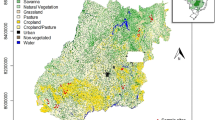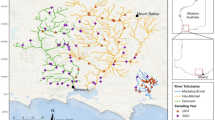Abstract
The effects of a mud snail, Cipangopaludina chinensis laeta (Martens) (Architaenioglossa: Viviparidae), on terrestrial arthropods through rice plant development in a paddy field were investigated in 2013 and 2014 by a field experiment. There were no significant differences between treatments in the abundance of aquatic organisms, which comprised several functional feeding groups in both years. The presence of mud snails did not significantly affect plant height and soil plant analysis development values, either, except in June 2014, when tiller number and biomass of the rice plants tended to be larger in plots with snails versus those without. Significantly higher abundances of terrestrial organisms, including phytophagous pest insects and other insects, but not natural enemies of the pest insects, occurred in plots with snails. As shown by principal component analysis, the community structure of the terrestrial organisms was significantly different between the two treatments in both years. The results of this study indicate that mud snails play an important role in the paddy field ecosystem, in which they influence the biomass production of rice plants and the abundance of organisms in terrestrial ecosystems through direct and indirect interactions at different trophic levels.




Similar content being viewed by others
References
Altieri MA, Nicholss CI (1999) Biodiversity, ecosystem function, and insect pest management in agricultural systems. In: Collins WW, Qualset CO (eds) Biodiversity in agroecosystems. CRC, New York, pp 69–84
Badshah MA, Naimei T, Zou Y, Ibrahim M, Wang K (2014) Yield and tillering response of super hybrid rice Liangyoupeijiu to tillage and establishment methods. Crop J 2(1):79–86. doi:10.1016/j.cj.2013.11.004
Barrion AT, Litsinger JA (1994) Taxonomy of rice insect pests and their arthropod parasites and predators. In: Heinrichs EA (ed) Biology and management of rice insects. Wiley, New Delhi, pp 13–359
Baxter CV, Fausch KD, Murakami M, Chapman PL (2004) Fish invasion restructures stream and forest food webs by interrupting reciprocal prey subsidies. Ecology 85:2656–2663. doi:10.1890/04-138
Beilen NV (2016) Effects of conventional and organic agricultural techniques on soil ecology. University of Toronto. Millersport Hwy. Getzville, New York. http://www.thinkcds.org. Accessed 25 Feb 2016
Bengtsson J, Ahnström J, Weibull AC (2005) The effects of organic agriculture on biodiversity and abundance: a meta-analysis. J Appl Ecol 42(2):261–269. doi:10.1111/j.1365-2664.2005.01005.x
Borror DJ, White RE (1970) A field guide to the insects of America north of Mexico. Houghton Mifflin, Boston, p 404
Cagauan AG (1995) Overview of the potential roles of pisciculture on pest and disease control and nutrient management in rice fields. In: Symoens JJ, Micha JC (eds) The management of integrated freshwater agropiscicultural ecosystems in tropical areas. Royal Academy of Overseas Science, Brussels, pp 203–244
Che Salmah MR, Hassan STS, Abu HA, Ali AB (2000) Life history of Neurothemis tullia (Drury) (Anisoptera: Libellulidae) in a tropical rain fed rice field. Odonatologica 28:1–11
Cheng W, Okamoto Y, Takei M, Tawaraya K, Yasuda H (2015) Combined use of Azolla and loach suppressed weed Monochoria vaginalis and increased rice yield without agrochemicals. Org Agric 5:1–10. doi:10.1007/s13165-015-0097-3
Chiu YW, Chen HC, Lee SC, Chen CA (2002) Morphometric analysis of shell and operculum variations in the viviparid snail, Cipangopaludina chinensis (Mollusca: Gastropoda), in Taiwan. Zool Stud 41:321–331
Cohen JE, Schoenly K, Heong KL, Justo H, Arida G, Barrion AT, Litsinger JA (1994) A food web approach to evaluating the effect of insecticide spraying on insect pest population dynamics in a Philippine irrigated rice ecosystem. J Appl Ecol 31:747–763. doi:10.2307/2404165
Cummins KW, Merritt RW, Andrade PCN (2005) The use of invertebrate functional groups to characterize ecosystem attributes in selected streams and rivers in south Brazil. Stud Neotrop Fauna E 40:69–89. doi:10.1080/01650520400025720
Delettre YR (2005) Short-range spatial patterning of terrestrial Chironomidae (Insecta: Diptera) and farmland heterogeneity. Pedobiologia 49:15–27. doi:10.1016/j.pedobi.2004.06.010
Delettre YR, Morvan N (2000) Dispersal of adult aquatic Chironomidae (Diptera) in agricultural landscapes. Freshwater Biol 44:399–411. doi:10.1046/j.1365-2427.2000.00578.x
Garbach K, Milder JC, Montenegro M, Karp DS, DeClerck FAJ (2014) Biodiversity and ecosystem services in agroecosystems. Encycl Agric Food Syst 2:21–40. doi:10.1016/B978-0-444-52512-3.00013-9
Gill HK, Grag H (2014) Pesticides: environmental impacts and management strategies. In Larramendy ML, Soloneski S (eds) Pesticides-toxic aspects. InTech, pp 187–230. doi:10.5772/57399
Grant IF, Tirol AC, Aziz T, Watanabe I (1983) Regulation of invertebrate grazers as a means to enhance biomass and nitrogen fixation of Cyanophyceae in wetland rice fields. Soil Sci Soc Am J 47(4):669–675. doi:10.2136/sssaj1983.03615995004700040013x
Halil S, Necmi B (2005) Selection for grain yield and its components in early generations in rice (Oryza Sativa L.). Trakya Univ J Sci 6(1):51–58
Hazra N, Pal G (2014) Effects of selected non-predators on the chironomid larvae (Diptera). Lap Lambert Academic, India
Hegde PR, Sreepada KS (2014) Reports on aquatic oligochaetes (Naididae) in paddy fields of Moodabidri Taluk, Dakshina Kannada, South India. J Entomol Zool Stud 2(2):101–107
Hirai K (1993) Recent trends of insecticide susceptibility in the brown planthopper, Nilaparvata lugens (Stål) (Homoptera: Delphacidae). Appl Entomol Zool 28(3):339–346
Ito T, Hara K (2010) Impact of tubificid worm on nutrient dynamics in paddy field. J Integr Field Sci 7:47–50
Japan Meteorological Agency (2013) Chiyoda-ku, Tokyo 100-8122, Japan (http://www.data.jma.go.jp/obd/stats/etrn/view/monthly_a1.php?prec_no=35&block_no=0263&year=2013). Accessed 9 Feb 2016
Japan Meteorological Agency (2014) Chiyoda-ku, Tokyo 100-8122, Japan (http://www.data.jma.go.jp/obd/stats/etrn/view/monthly_a1.php?prec_no=35&block_no=0263&year=2014). Accessed 9 Feb 2016
Kagata H, Nakamua M, Ohgushi T (2005) Bottom-up cascade in a tri-trophic system: different impacts of host plant regeneration on performance of a willow leaf beetle and its natural enemy. Ecol Entomol 30:58–62
Koricheva J, Mulder CPH, Schmid B, Joshi J, Huss-Danell K (2000) Numerical responses of different trophic groups of invertebrates to manipulations of plant diversity in grasslands. Oecologia 125:271–282
Kurihara Y, Kadowaki KI (1988) Effect of different ecological conditions on the mud snail (Cipangopaludina japonica) in submerged paddy soil. Biol Fertil Soils 6:292–297. doi:10.1007/BF00261015
Letourneau DK, Bothwell SG (2008) Comparison of organic and conventional farms: challenging ecologists to make biodiversity functional. Front Ecol Environ 6(8):430–438. doi:10.1890/070081
Li X, Qian Q, Fu Z, Wang Y, Xiong G, Zeng D, Wang X, Liu X, Teng S, Hiroshi F, Yuan M, Luo D, Han B, Li J (2003) Control of tillering in rice. Nature 422:618–621. doi:10.1038/nature01518
Merritt RW, Cummins KW (1996) An introduction to the aquatic insects of North America. Kendall/Hunt, Dubuque
Moran VC, Southwood TRE (1982) The guild composition of arthropod communities in trees. J Anim Ecol 51:289–306. doi:10.2307/4325
Mukai Y, Baba N, Ishii M (2005) The water system of traditional rice paddies as an important habitat of the giant water bug, Lethocerus deyrollei (Heteroptera: Belostomatidae). J Insect Conserv 9:121–129. doi:10.1007/s10841-005-3488-z
Natuhara Y (2013) Ecosystem services by paddy fields as substitutes of natural wetlands in Japan. Ecol Eng 56:97–106. doi:10.1016/j.ecoleng.2012.04.026
Perner J, Wytrykush C, Kahmen A, Buchmann N, Egerer I, Creutzburg S, Odat N, Audorff V, Weisser WW (2005) Effects of plant diversity, plant productivity and habitat parameters on arthropod abundance in montane European grasslands. Ecography 28:429–442. doi:10.1111/j.0906-7590.2005.04119.x
Pinder LCV (1995) The habitats of chironomid larvae. In: Armitage PD, Cranston PS, Pinder LCV (eds) The Chironomidae: biology and ecology of non-biting midges. Chapman & Hall, London, pp 107–135
R Core Team (2015) R: a language and environment for statistical computing. R Foundation for Statistical Computing, Vienna. http://www.R-project.org/. Accessed 16 August 2015
Rambo JL, Faeth SH (1999) Effect of vertebrate grazing on plant and insect community structure. Conserv Biol 13:1047–1054. doi:10.1046/j.1523-1739.1999.98504.x
Sabo JL, Power ME (2002) River-watershed exchange: effects of riverine subsidies on riparian lizards and their terrestrial prey. Ecology 83:1860–1869. doi:10.2307/3071770
Settle WH, Ariawan H, Astuti ET, Cahyana W, Hakim AL, Hindayana D, Lestari AS (1996) Managing tropical rice pests through conservation of generalist natural enemies and alternative prey. Ecology 77:1975–1988. doi:10.2307/2265694
Simpson IC, Roger PA, Oficial R, Grant IF (1993) Density and composition of aquatic oligochaete populations in different farmers’ ricefields. Biol Fertil Soils 16:34–40. doi:10.1007/BF00336512
Simpson IC, Roger PA, Oficial R, Grant IF (1994) Effects of nitrogen fertilizer and pesticide management on floodwater ecology in a wetland ricefield. III. Dynamics of benthic molluscs. Biol Fertil Soils 18:219–227. doi:10.1007/BF00647670
Stiling P, Moon DC (2005) Quality or quantity: the direct and indirect effects of host plants on herbivores and their natural enemies. Oecologia 142:413–420. doi:10.1007/s00442-004-1739-4
Tilman D, Cassman KG, Matson PA, Naylor R, Polasky S (2002) Agricultural sustainability and intensive production practices. Nature 418:671–677. doi:10.1038/nature01014
Trisnawati DW (2012) The effect of organic and conventional management strategies on biodiversity and ecoystem functioning in paddy fields. Thesis, Graduate School of Agriculture, Yamagata University
Trisnawati DW (2015) Effects of bio-based nutrient on the growth of rice plants in relation to abundance of aboveground arthropods in organic paddy fields with different histories of management. Dissertation, United Graduate School of Agriculture Sciences of Iwate University, Constituent Yamagata University
Underwood GJC, Thomas JD, Baker JH (1992) An experimental investigation of interactions in snail-macrophyte-epiphyte systems. Oecologia 91:587–595. doi:10.1007/BF00650335
Utsumi S, Ohgushi T (2009) Community-wide impacts of herbivore-induced plant regrowth on arthropods in a multi-willow species system. Oikos 118:1805–1815. doi:10.1111/j.1600-0706.2009.17580.x
Vromant N, Chau NTH (2005) Overall effect of rice biomass and fish on the aquatic ecology of experimental rice plots. Agric Ecosyst Environ 111:153–165. doi:10.1016/j.agee.2005.06.015
Walker M, Hartley SE, Jones TH (2008) The relative importance of resources and natural enemies in determining herbivore abundance: thistles, tephritids and parasitoids. J Anim Ecol 77:1063–1071. doi:10.1111/j.1365-2656.2008.01406.x
Wilson AL, Watts RJ, Stevens MM (2008) Effects of different management regimes on aquatic macroinvertebrate diversity in Australian rice fields. Ecol Res 23:565–572. doi:10.1007/s11284-007-0410-z
Xu JX, Wu JC (1999) On the significance, role and manipulating of neutral insects in paddy ecosystem. Chin J Ecol 18:41–44 (in Chinese with English abstract)
Xu G, Fan X, Miller AJ (2012) Plant nitrogen assimilation and use efficiency. Annu Rev Plant Biol 63:153–182. doi:10.1146/annurev-arplant-042811-105532
Yadav SK, Babu S, Yadav MK, Singh K, Yadav GS, Pal S (2013) A review of organic farming for sustainable agriculture in Northern India. doi:10.1155/2013/718145
Zhong Q, Benliang Z, Jia-en Z, Shiming L (2011) Study on diversity of arthropod community in a rice-duck integrated farming system in South China. J Resour Ecol 2:151–157. doi:10.3969/j.issn.1674-764x.2011.02.007
Acknowledgments
We thank Prof. Edward Evans (Utah State University) for helpful comments and for improving the English. We also appreciate the two anonymous reviewers for their valuable suggestions and comments. This study was supported by funding from a grant-in-aid from the Japan Society for the Promotion of Science (no. 26440229).
Author information
Authors and Affiliations
Corresponding author
Rights and permissions
About this article
Cite this article
Dewi, V.K., Sato, S. & Yasuda, H. Effects of a mud snail Cipangopaludina chinensis laeta (Architaenioglossa: Viviparidae) on the abundance of terrestrial arthropods through rice plant development in a paddy field. Appl Entomol Zool 52, 97–106 (2017). https://doi.org/10.1007/s13355-016-0458-8
Received:
Accepted:
Published:
Issue Date:
DOI: https://doi.org/10.1007/s13355-016-0458-8




